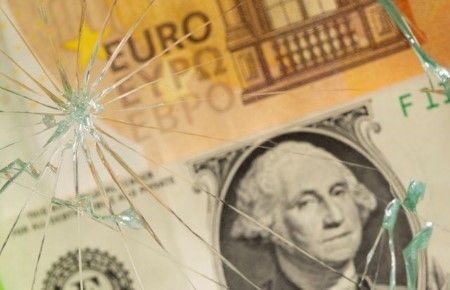




Philippines Trade Update: Exports momentum continues
 DOWNLOAD
DOWNLOAD

Quarterly Economic Growth Release: More BSP cuts to come
 DOWNLOAD
DOWNLOAD

Monthly Economic Update: Fed catches up
 DOWNLOAD
DOWNLOAD


BUZZ-COMMENT-US recap: Global risk aversion delivers body blow to EUR/USD

May 12 (Reuters) – The euro tumbled against the dollar and yen on Thursday as intensifying global risk aversion over war, inflation and diminishing economic growth prospects sent investors scrambling into the safe-haven dollar and yen.
The souring sentiment dealt a particularly harsh blow to the euro since it is exposed to Ukraine war risks nL3N2WY13J and China’s COVID-related economic disruptions nL2N2X40OH while also dealing with the ECB’s delayed entry into the fight against inflation.
EUR/JPY plunged 2.8% and EUR/USD tumbled 1.4%.
Highlighting the unwinding of carry trades and other riskier ventures, USD/JPY slumped 1.4% even as the dollar index rose nearly 1% to 19-1/2-year highs nL2N2X41IQ.
EUR/USD was approaching 2017’s 1.0340 low, the last crucial support before parity, below which the all-time low at 0.8228 might attract traders as a lengthy list of risks — including inflation, energy insecurity, economic growth and peripheral debt servicing issues — confronts policymakers.
Bund yields fell faster than Treasury yields during this week’s financial market duress, leaving EUR/USD in a precarious position as it approaches the 2017 lows nL2N2X41HW.
USD/JPY faced daily and weekly sell signals but held weekly range support at 127.53 near the 127.41 daily kijun. BOJ-corralled JGB yields abetted the risk-off slide in 2-year Treasury-JGB yields spreads, down 30bp since last week’s close, adding to USD/JPY selling.
Unwinding of spec-heavy and extremely overbought USD/JPY longs has it threatening support by 127, with 125 next nL2N2X41RT.
Sterling sank 0.6% to its lowest in two years due to the dollar’s broad advance.
Cable was spared EUR/USD’s deeper losses partly because specs were already heavily short sterling versus nearly flat EUR/USD coming into this week and the BoE’s early start to rate hikes offers some carry trade cushion versus the mere expectation for ECB rate hikes to begin in H2.
But UK economic worries being far more dire than those for the U.S. were reinforced by weaker-than-forecast UK data nL2N2X41EE.
Major sterling support is April 2020’s 1.2075 swing low by the 76.4% Fibo of the entire pandemic recovery range at 1.2082, below which is the 2020 spike low at 1.1413.
USD/CNH gained nearly a percent to its highest since September 2020, adding to the staggering 8% surge since March’s lows, as Chinese economic concerns mount and the PBOC avoids meaningful rate cuts to avert faster capital outflows.
The Australian and New Zealand dollars fell 1.5% and 1.2%, respectively, amid risk-off flows and Chinese worries. Risk-gauge AUD/JPY collapsed 2.9% to 87.42 by the 50% Fibo of the December-April rally at 87.25.
Bitcoin recovered most of its early plunge to its lowest since December 2020, while ether mounted only a partial recovery from its plunge to June 2021’s 1,700 nadir, both hobbled by stablecoin dollar peg breaches nL2N2X4098 and broader risk aversion.
May Michigan sentiment tops Friday’s data calendar, with most now focused on next Tuesday’s retail sales report.
For more click on FXBUZ
(Editing by Burton Frierson
Randolph Donney is a Reuters market analyst. The views expressed are his own.)
This article originally appeared on reuters.com





 By Reuters
By Reuters